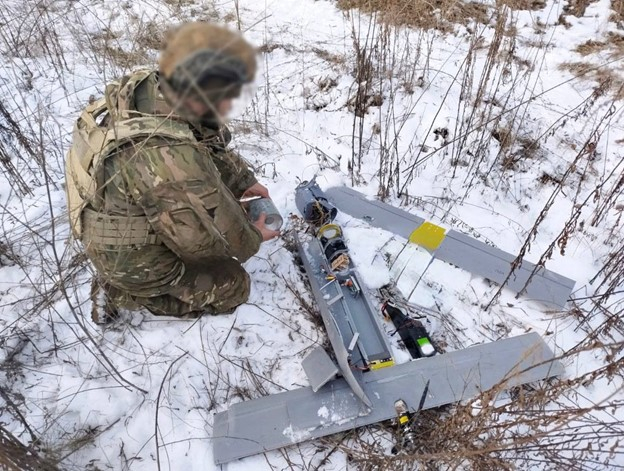Russia is believed to have been deploying experimental drones that include artificial intelligence (AI) enhanced components in recent months.
While crude on the outside, the drones boast a range of high-end digital components that indicate the probable use of AI to improve targeting and accuracy.
JOIN US ON TELEGRAM
Follow our coverage of the war on the @Kyivpost_official.
Serhii “Flash” Beskrestnov, a Ukrainian milblogger specializing in radio communications, shared the findings in a Monday Telegram update, which included pictures and descriptions of the drones.
Beskrestnov said the drone’s usage was first recorded in Ukraine’s Sumy region in February, but they have since been spotted in other sectors of the eastern front.
Visually, the drones, with their angular wings and hulls crudely welded together, lack the refinements normally associated with serialized production drones such as Russian Lancet or Shahed / Geran drones.
“At first glance, the [unmanned aerial vehicle] UAV does not cause much interest, but inside it is an absolutely innovative product,” Beskrestnov said in his update.
Basic specifications
He said the drone is powered electronically with a 34-amp-hour (Ah) battery that would allow it to carry a 3-kilogram (6.6-lbs) warhead over an 80-kilometer (50-mile) range; for context, an iPhone 16 employs a 3.56 Ah battery.
Pictures shared by Beskrestnov showed a Russian OLA-15T explosive charge, which a Canadian milblogger identified as “an octogen (HMX) explosive with 15% aluminum for incendiary effect,” who added that the drone’s range is likely 40-60 kilometers (25-37 miles) with the warhead.

Other Topics of Interest
US Remains Key Mediator and Supports Ukraine’s Efforts To End War, State Dept Says
‘Our commitment is not one that is fainting. It is not one that was brief,’ State Department’s Spokesperson Tammy Bruce tells Kyiv Post’s correspondent.
The warhead was also named in a Russian research paper on explosives.
Complex electronics
What surprised Beskrestnov was the complex electronics spotted inside the drone, which he described as an “absolutely innovative product.”
Some of the features and modules found on the drone are summarized below:
- Guidance – on top of satellite and inertial navigation system (INS) commonly seen in UAVs, the drone also sports mobile LTE/4G internet modules that theoretically allow it to access the internet en route, enabling it to be controlled remotely or receive updated guidance data
- Visual recognition – it has a “powerful 14 MP camera,” in the form of a JETSON video recognition and processing module
- Range-finding – it also has an unspecified model of laser rangefinder, “which allows the UAV to navigate using a height map”
- Onboard data – the drone houses a “high-speed hard drive” with over 100 gigabytes of navigation data
The combination of the electronics, and the fact that the drones were detected flying in groups of two to six at once, led to Beskrestnov’s speculation that Russia has achieved some form of AI-enabled drone swarm – a breakthrough in drone development that Kyiv and Moscow (among many others) have been trying to achieve.
In addition, the computing power and data onboard mean the drones might be capable of evading air defense, identifying targets autonomously, and adjusting their flight path accordingly.
“This type of strike UAV is considered by many experts to be the future, because the drone is controlled by artificial intelligence, and doesn’t depend on satellite navigation signals and its control cannot be suppressed by electronic warfare. Such a drone can potentially even record the operation of air defense and anti-aircraft drones and perform evasive maneuvers,” Beskrestnov said.
He said the drone is “becoming more and more common” and called for Ukrainian drone experts to study and potentially develop similar variants to offset the Russian advantages.

